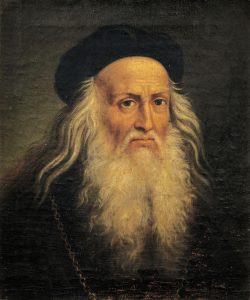The Stone Age Didn’t End Because They Ran Out of Stones
“Creativity is thinking up new things. Innovation is doing new things.” – Theodore Levitt
May 14, 2018 ~ Written by: W.B. “Bud” Kirchner
The title of this article originates from a larger quote from former Saudi oil minister Sheik Ahmed Zaki Yamani. It finishes with a reference to inventing bronze tools…
When I hear it – I think of the more fundamental: innovation and creativity.
I have now read twice (that is over 1,000 pages total if you are counting!) the masterpiece by Walter Isaacson regarding Leanardo da Vinci. This theme is not foreign to him having written similarly on Einstein and Steve Jobs. With this resume in mind, I couldn’t help but take note of his effort to highlight the “lessons” inherent in da Vinci and his work.
Just to be clear, my objective in this article is not to do a book review or a historical reenactment of the life and accomplishments of da Vinci but rather to repeat some (20 to be specific) lessons identified by the author that can be drawn upon in the context of creativity and/or innovation – everyday challenges in the world of business.
Content
“The difficulty lies not so much in developing new ideas as in escaping from old ones.” – John Maynard Keynes
Per Isaacson, the following are the twenty “lessons” as illustrated by da Vinci in this case but by many others that are easily recalled.
- Relentlessly curious
- Seek knowledge for its own sake
- Retain a childlike sense of wonder
- Observe
- Start with the details
- See things unseen
- Go down rabbit holes
- Get distracted
- Respect facts
- Procrastinate
- Let the perfect be the enemy of the good
- Think visually
- Avoid silos
- Let your reach exceed your grasp
- Indulge fantasy
- Create for yourself not just patrons
- Collaborate
- Make lists
- Take notes
- Be open to a mystery
Presumably one draws on various lessons to various degrees depending on the challenge/vision at hand. Similarly, it seems that individual profiles evolve in any given individual. Nevertheless, the vast majority of these are worthy of note. Having said this – I believe there are a few of these lessons worthy of a bit more discussion.
Seek knowledge for its own sake
I have written on numerous occasions on the concepts of metacognition (How Did I Get Here From There?) in general and neuroplasticity (Your brain: How “committees” on terrorism, concerts and weddings guide you) specifically. Point being that like a muscle we develop strengths and faculties that ultimately make the brain more efficient and accurate thus encouraging innovation/creativity. Given the vast (but not unlimited) capacity of the brain – presumably the more you seek knowledge – circuits are exercised – the more dominant they become. Thus there is a philosophical (knowledge for the joy of knowledge) and practical (efficiency) component to this lesson.
Collaborate
Collaboration (of course) takes on a much more robust meaning today than during the Renaissance period. Social media has created vast scope for collaboration so now the challenge becomes one of balance with other networking activities. I would argue that as ideas move from creativity to innovation the benefit analysis of social media increases. I am struck in this context by the contrast of strong links and weak network links as they reflect the balance of support and challenges essential to ideas and implementation.
Observe
First – I believe this lesson embraces several of the others – such as avoiding silos, seeing things unseen etc. etc. I would suggest the salient (unspoken) component of this is observing relationships not just cause/effect but empirical observations on correlation. I believe it is the juxtaposition of action and reaction that is facilitated by observation.
In summary – each of these lessons represent a Pandora’s box of issues!
Chemistry
“Creativity is allowing oneself to make mistakes. Art is knowing which ones to keep.” – Scott Adams
The synthesis of these 20 ingredients listed above is described by Isaacson thusly: (Emphasis is my own.)
- “Ability to make connections across disciplines – arts and sciences, humanities and technology – is a key to innovation, imagination, and genius.”
- “Leonardo knew how to marry observation and imagination, which made him history’s consummate innovator.”
Further reflecting on these observations, they are, at a minimum, encouraging to the mortals amongst us. As we struggle with ordinary minds – quirkiness – lack of drive. We can take comfort from Isaacson’s further comments:
- “In fact, Leonardo’s genius was a human one, wrought by his own will and ambition. It did not come from being the divine recipient, like Newton or Einstein, of a mind with so much processing power.”
- “Leonardo was not only a genius but also very human – quirky and obsessive and playful and easily distracted.”
- “Men of lofty genius sometimes accomplish the most when they work least.”
As if that isn’t enough reason for hope.
As the New Yorker art critic, Adam Gopnik once wrote, “Leonardo remains weird, matchlessly weird, and nothing to be done about it.”
Given the above – is there really a good reason for each and every one of us to not feel capable of innovation and creativity? In other words, we can all contribute to solving problems.
Conclusion
In closing, I cite a quote to bring it all back to our ever prevalent business context:
“Innovation is the ability to convert ideas into invoices.” – L. Duncan
Bibliography
Walter Isaacson – Leonardo da Vinci
Related Business Brain Model articles:
- How Did I Get Here From There?
- Your brain: How “committees” on terrorism, concerts and weddings guide you
About the Author: W.B. “Bud” Kirchner is a serial entrepreneur and philanthropist with more than 50 years of business success. He is not a scientist or an academic but he does have a diversified exposure to neuroscience, psychology and related cognitive sciences. Generally speaking, the ideas he expresses here are business-angled expansions of other people’s ideas, so when possible, he will link to the original reference.



